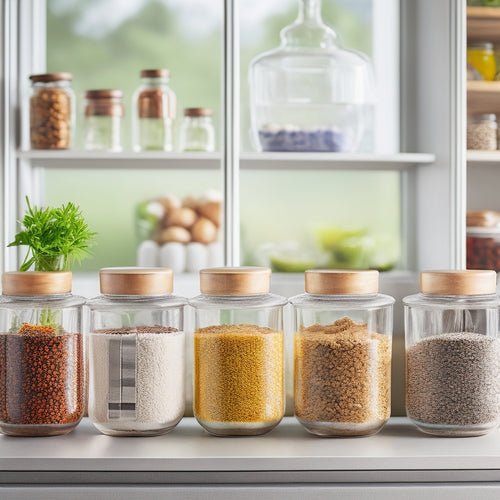
Cooking Oil Selection Simplified
Share
Cooking oil selection involves understanding the distinctive traits of different oils, including smoke points, flavor profiles, and nutritional benefits. Smoke points determine cooking method compatibility, while flavor profiles range from subtle to bold, impacting dish taste. Health benefits include heart-healthy unsaturated fats. By considering these factors, home cooks can make informed decisions, ensuring best results and kitchen safety. From extra virgin olive oil to avocado oil, each oil has its ideal uses and storage requirements. By grasping these basics, you'll be well-equipped to navigate the world of cooking oils and discover new flavors and possibilities in your kitchen.
Key Takeaways
• Cooking oil selection depends on heat tolerance, nutritional value, and flavor profile to ensure optimal results and kitchen safety.
• Understanding smoke points helps determine compatible cooking methods, preventing oil degradation and harmful compounds.
• Flavor profiles range from mild to robust, impacting dish taste, and should be considered when pairing oils with ingredients.
• Different oils excel in various cooking methods, such as grilling, sautéing, baking, and frying, so choose accordingly.
• Storage requirements and shelf life vary among oils, so proper storage ensures freshness and prevents spoilage.
Understanding Cooking Oil Basics
The foundation of effective cooking oil selection lies in grasping the fundamental characteristics that distinguish one oil from another, including smoke points, nutritional profiles, and flavor profiles.
Flavor profiles, which can range from mild to robust, greatly impact the overall taste of a dish.
Health benefits, such as heart-healthy unsaturated fats, are also important considerations.
Additionally, cooking method compatibility is essential, as oils with high smoke points are better suited for high-heat cooking, while those with lower smoke points are ideal for low-heat or raw consumption.
Moreover, shelf life and storage requirements must be considered to guarantee the oil remains fresh and safe for use.
Decoding the Kitchen Cabinet Kings
Kitchen Cabinet Kings' detailed cheat sheet provides a thorough breakdown of 21 cooking oils, empowering home cooks and professional chefs alike to make informed decisions about the best oil for their specific culinary needs. This valuable resource simplifies the oil selection process, ensuring that cooks can choose the perfect oil for their recipe.
Here are three key takeaways from the Kitchen Cabinet Kings' cheat sheet:
-
Oil selection is influenced by factors such as heat tolerance, nutritional value, and flavor profile.
-
The cheat sheet provides kitchen tips on ideal cooking uses, food pairings, and storage recommendations for each oil.
-
By understanding the characteristics of different oils, cooks can make informed decisions about the best oil for their specific culinary needs, resulting in better-tasting dishes and improved kitchen safety.
Oil Characteristics and Uses
Flavorful dishes often pivot on the careful selection of cooking oils, which can enhance or detract from the culinary experience depending on their unique characteristics and uses. When opting for a cooking oil, it's crucial to take into account the flavor profile and culinary application. Different oils are suitable for specific cooking methods, and grasping their characteristics can make all the difference.
| Oil Type | Flavor Profile and Culinary Applications |
|---|---|
| Extra Virgin Olive Oil | Rich, fruity taste; perfect for raw consumption, salad dressings, and low-heat cooking |
| Avocado Oil | Mild, buttery taste; appropriate for high-heat cooking, grilling, and sautéing |
| Coconut Oil | Distinct, nutty taste; perfect for baking, sautéing, and making desserts |
| Peanut Oil | Strong, nutty taste; frequently used in Asian cuisine for stir-frying and deep-frying |
Mastering Smoke Points and Safety
When it comes to cooking with oil, understanding the smoke point is crucial for safety and flavor preservation. It determines the temperature at which an oil begins to degrade and potentially becomes harmful. Ignoring smoke points can lead to health risks, including the formation of harmful compounds and nutritional degradation.
To guarantee oil safety, follow these guidelines:
-
Select oils with high smoke points for high-heat cooking, such as avocado or peanut oil.
-
Apply gentle heat with oils like olive or coconut oil, which have lower smoke points.
-
Monitor temperatures to prevent overheating, which can compromise oil quality and safety.
Exploring the World of Oils
Beyond the familiar staples of olive and vegetable oil, a diverse array of cooking oils exists, each with its unique characteristics, nutritional profiles, and culinary applications. This variety offers a range of health benefits, flavor profiles, and culinary applications.
| Oil Type | Characteristics |
|---|---|
| Avocado Oil | High smoke point, mild flavor, suitable for frying |
| Coconut Oil | Solid at room temperature, high in saturated fats, ideal for baking |
| Grapeseed Oil | Light, neutral flavor, high smoke point, perfect for sautéing |
| Peanut Oil | Distinct nutty flavor, high smoke point, commonly used in Asian cuisine |
| Sesame Oil | Strong, nutty flavor, low smoke point, ideal for dressings and marinades |
When selecting a cooking oil, consider the specific health benefits, flavor profiles, and culinary applications required for your dish. Additionally, don't forget to follow proper storage tips to maintain the oil's quality and shelf life.
Frequently Asked Questions
How Do I Properly Store Cooking Oils to Maintain Their Quality?
To maintain quality, properly store cooking oils in a cool, dark place, such as a pantry or cupboard, away from heat sources and direct sunlight, and guarantee tight-fitting lids to prevent oxidation and contamination.
Can I Reuse Cooking Oil, and if So, How Many Times?
"Reusing cooking oil can be risky, as it may lead to the formation of harmful compounds, posing health risks. It's generally recommended to reuse oil no more than 2-3 times, and then dispose of it responsibly to minimize environmental impact."
Are All Cooking Oils Suitable for People With Nut Allergies?
Not all cooking oils are suitable for individuals with nut allergies; peanut oil, for instance, poses a significant risk. Nut-free options, such as canola or avocado oil, are safer alternatives, emphasizing the importance of allergen considerations in cooking oil selection.
Can Cooking Oils Be Used as a Substitute for Butter in Baking?
When substituting cooking oils for butter in baking, consider flavor impact and fat content. Neutral-tasting oils like canola or avocado work well, while infused oils may alter flavor profiles.
Do Organic Cooking Oils Have More Health Benefits Than Non-Organic Options?
In a study, organic avocado oil was found to have higher levels of antioxidants and lower pesticide residues compared to non-organic options, offering a nutritional advantage; however, the environmental impact, cost analysis, and taste preference ultimately influence the decision.
Related Posts
-

Innovative Lazy Susan Storage Solutions
Innovative Lazy Susan storage solutions are a revolutionary advancement for any space, especially in kitchens. They m...
-

Stackable Kitchen Containers for Dry Goods
Stackable kitchen containers are perfect for organizing dry goods and maximizing your kitchen space. They help reduce...
-

Creating More Space in a Tiny Kitchen
You can alter your tiny kitchen into a more spacious haven by utilizing smart storage solutions. Install wall-mounted...


